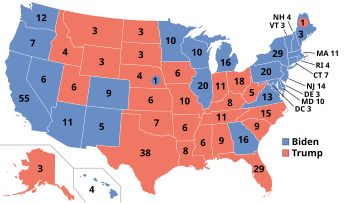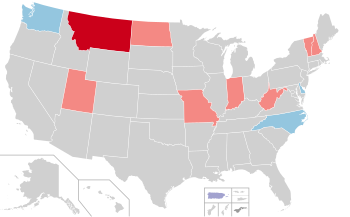
Back انتخابات الولايات المتحدة الأمريكية 2020 Arabic মার্কিন যুক্তরাষ্ট্রের নির্বাচন ২০২০ Bengali/Bangla ھەڵبژاردنەکانی ویلایەتە یەکگرتووەکانی ئەمریکا (٢٠٢٠) CKB Wahlen in den Vereinigten Staaten 2020 German Elecciones de los Estados Unidos de 2020 Spanish Yhdysvaltain vaalit 2020 Finnish Élections de 2020 aux États-Unis French הבחירות בארצות הברית (2020) HE Kosningar í Bandaríkjunum 2020 Icelandic Elezioni parlamentari negli Stati Uniti d'America del 2020 Italian
| ← 2018 2019 2020 2021 2022 → Presidential election year | |
| Election day | November 3 |
|---|---|
| Incumbent president | Donald Trump (Republican) |
| Next Congress | 117th |
| Presidential election | |
| Partisan control | Democratic gain |
| Popular vote margin | Democratic +4.5% |
| Electoral vote | |
| Joe Biden (D) | 306 |
| Donald Trump (R) | 232 |
 | |
| Presidential election results map. Blue denotes states won by Biden/Harris, and red denotes states won by Trump/Pence. Numbers indicate electoral votes allotted to the winner of each state or district. | |
| Senate elections | |
| Overall control | Democratic gain[a] |
| Seats contested | 35 of 100 seats (33 seats of Class II + 2 special elections) |
| Net seat change | Democratic +3 |
 | |
| Map of the 2020 Senate races (Georgia held two Senate elections) Democratic hold Republican hold Democratic gain Republican gain No election | |
| House elections | |
| Overall control | Democratic hold |
| Seats contested | All 435 voting-members All six non-voting delegates |
| Popular vote margin | Democratic +3.1% |
| Net seat change | Republican +13 |
 | |
| Map of the 2020 House of Representatives elections
Democratic hold Republican hold Democratic gain Republican gain | |
| Gubernatorial elections | |
| Seats contested | 13 (11 states, two territories) |
| Net seat change | Republican +1 |
 | |
| Map of the 2020 gubernatorial races
Democratic hold Republican hold Republican gain New Progressive hold Nonpartisan No election | |
The 2020 United States elections were held on Tuesday, November 3, 2020. The Democratic Party's nominee, former vice president Joe Biden, defeated incumbent Republican president Donald Trump in the presidential election. Despite losing seats in the House of Representatives, Democrats retained control of the House and gained control of the Senate. As a result, the Democrats obtained a government trifecta, the first time since the elections in 2008 that the party gained unified control of Congress and the presidency.[1] With Trump losing his bid for re-election, he became the first president to have seen his party lose the presidency and control of both the House and the Senate since Herbert Hoover in 1932.[2][3] This was the first time since 1980 that either chamber of Congress flipped partisan control in a presidential year, and the first time Democrats did so since 1948.
Biden became his party's nominee after defeating numerous challengers in the Democratic primaries, while Trump faced token opposition in the Republican primaries. In the congressional elections, Democrats lost seats in the House of Representatives but retained their majority in the chamber by a narrow margin. Democrats made a net gain of three seats in the Senate for a total of 50 seats, taking control of the chamber as newly elected vice-president Kamala Harris could cast tie-breaking votes. Contests for the six non-voting congressional delegates from the District of Columbia and the permanently inhabited U.S. territories were also held during the 2020 elections.
Regularly-scheduled elections were held in 86 of the 99 state legislative chambers, and 11 states held their gubernatorial elections. Only one state governorship and two legislative chambers changed partisan control, as Republicans won the gubernatorial race in Montana and gained control of both legislative chambers in New Hampshire. Various other state executive and judicial elections, as well as numerous referendums, tribal elections, mayoral elections, and other local elections, also took place in 2020. The 2020 elections were the last major set of elections to impact the redistricting cycle that will take place following the 2020 census. Significant issues for voters included the ongoing COVID-19 pandemic, as well as health care, the economy, racial unrest and climate change. Social distancing guidelines resulted in unprecedented levels of postal voting and early voting. Voter turnout greatly exceeded recent elections; one projection has turnout by voting eligible population being higher than any election since 1900.
After Biden won the election, Trump and other Republicans refused to concede, making baseless and disproven claims of widespread voter fraud,[4][5][6] despite U.S. election security officials saying that the election was "the most secure in American history".[7] These attempts to overturn the election resulted in a deadly attack on the U.S. Capitol, which led to Trump being impeached for the second time and deplatformed across several major social media platforms.[8][9][10]
Cite error: There are <ref group=lower-alpha> tags or {{efn}} templates on this page, but the references will not show without a {{reflist|group=lower-alpha}} template or {{notelist}} template (see the help page).
- ^ "Statistics of the Presidential and Congressional Election of November 3, 2020". U.S. House of Reps, Office of the Clerk. Retrieved April 16, 2021.
- ^ Enten, Harry (January 10, 2021). "How Trump led Republicans to historic losses". CNN. Archived from the original on January 14, 2021. Retrieved February 3, 2021.
- ^ Liasson, Mara (January 15, 2021). "Examining The Fault Lines Of The Republican Party". National Public Radio (NPR). Archived from the original on February 20, 2021. Retrieved February 3, 2021.
- ^ "McConnell-led Republicans hold steady against Trump concession". Politico. November 9, 2020. Archived from the original on November 10, 2020. Retrieved November 10, 2020.
- ^ Cochrane, Emily; Fandos, Nicholas (November 9, 2020). "Declining to recognize Biden's victory, McConnell says Trump is '100 percent' entitled to challenge it". The New York Times. ISSN 0362-4331. Archived from the original on November 10, 2020. Retrieved November 10, 2020.
- ^ Barrett, Ted; Raju, Manu; Foran, Clare (November 5, 2020). "Top Republicans defend Trump on baseless voter fraud claims as concerns grow in the ranks". CNN. Archived from the original on November 16, 2020. Retrieved November 10, 2020.
- ^ Election Infrastructure Government Coordinating Council (November 12, 2020). "Joint Statement from Elections Infrastructure Government Coordinating Council & the Election Infrastructure Sector Coordinating Executive Committees". CISA. Retrieved June 9, 2022.
- ^ Fung, Brian (January 8, 2021). "Twitter bans President Trump permanently". CNN. Archived from the original on January 12, 2021. Retrieved June 5, 2021.
- ^ "Facebook says Donald Trump to remain banned for two years, effective from Jan. 7". CNBC. June 4, 2021.
- ^ "Snapchat permanently bans Trump". Politico. January 13, 2021.